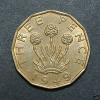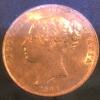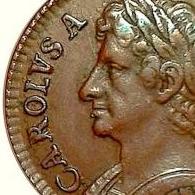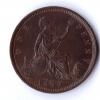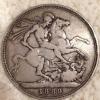This is a moot point and I'm not convinced. It is also part of a much broader question.
Rawlins was in Bristol making tokens in 1652 whereas Ramage was employed at the mint. https://en.wikipedia.org/wiki/Thomas_Rawlins Note the lozenge stops so characteristic of Rawlins' work. However, both Rawlins and Ramage studied under Briot, so the pair will undoubtedly have learned and practised similar skills and methods. Ramage also used lozenges, but I can't make a case for Rawlins ever using mullets.
It is somewhat unhelpful that Ramage and Rawlins share the same initial for their surname. With Rawkins in France from 1648 to 1652 following the Civil War, there is no debate about the engraver of the 1651 patterns, nor the significance of the mullets. As the resident engraver at the mint for the duration of the Commonwealth, the R is unambiguous in the case of the early three pillars dies and those of the Cromwell farthings for the simple reason that Rawlins was known to be elsewhere, but from the restoration in 1660 things become a little muddy. The reinstallation of Thomas Rawlins as chief engraver would lead one to think that the R referred to him in every instance post-1660, but with David Ramage also employed as engraver at the mint and having similarly signed the dies with an R, the jury is out. The three pillars was a symbol of the Commonwealth and as such, unlikely to find favour in the court of Charles II.
It is very tempting to say that anything with 5 pointed mullets was done by Ramage, but all the pattern farthings and the 1651 pattern halfcrown use both a mullet and a lozenge in the legends. This is not unexpected as a former pupil of Broit's. The early 3 pillars dies had an R below the central pillar. This P473 (which has both mullets and a lozenge on the obverse, as do the other 3 pillars dies) has a disturbed area in the field below the central pillar when angled best towards the light and this is commensurate with a filled die. Further clues may lie in the pattern farthings P474, 483 & 484. The first has a large bust with both mullets and a lozenge in the legend; the second has a smaller bust, signed R below, and only lozenges in the legend; the third uses the same smaller bust punch, but isn't signed and is a different die with the bust entered lower on the die and uses both a lozenge and mullets in the legend. If anything is to be interpreted from this, it is that Rawlins consistently used lozenges but not mullets. I also think it is reasonable to say that those with mullets were done by Ramage.
If everybody gets their copy of Peck out , they can contribute an opinion. Discuss.
 Coinpublications.com
Coinpublications.com


